► Who makes the best electric crossover?
► Fiat 600e vs Hyundai Kona Electric vs Honda e:Ny1
► Tested: one of the most popular types of EV
Memo to British Prime Minister Rishi Sunak: delaying the ban on the sale of new petrol and diesel cars won’t turn the tidal wave of new EVs. It just makes you look like a Canute.
These three new electric crossover-SUVs, in the heart of the UK and Europe’s most popular market segment, make that very clear. Fiat, Hyundai and Honda – like all car makers – are being much braver and long-termist than Britain’s right-wing PM, desperately seeking votes in misguided populism. The auto industry won’t dither, knowing it must hone its battery tech and cost propositions now, to convert car buyers to EV and meet its obligations on climate change and local air quality.
Hyundai has led on EVs, that’s why its second-generation Hyundai Kona Electric is battling first-generation e-SUVs from Fiat and Honda. While the Kona’s drivetrain shares much with its predecessor – carryover electric motors, two battery sizes – the vehicle architecture is new.
And it’s significantly bigger: this Kona measures 4355mm-long, a 150mm growth spurt, and there’s an extra 60mm between the wheels to boost interior space. The larger platform – designed for electric vehicles first although it supports petrol and hybrid too – means the previous entry-level model’s 39.2kWh pack can be upgraded to 48.6kWh. Prices start at £34,995 or £38,595 for the biggest battery.
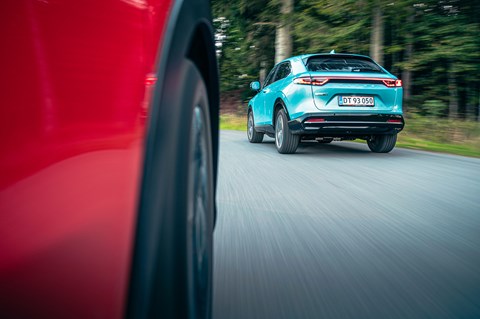
The Fiat 600e will ultimately replace the purely combustion 500X and continues its philosophy: Fiat’s SUV alternative for buyers entranced by the 500’s cute city car shtick but needing a little more utility. It shares its underpinnings with the Jeep Avenger and DS 3 E-Tense, which means a compact 4171mm length and 51kWh usable battery. That’s the smallest powerpack in this trio and the lowest entry price of £32,995 too.
Honda has engineered some memorable hybrids but has lagged on electric. The Honda E, combining a tiny range and package with a sizeable price tag, has unsurprisingly proved deeply resistible. Its response is the new Honda e:Ny1, which makes a better web password than car name. It’s a smidge longer than the Kona, packs a 61.9kWh usable battery and costs from £44,995.
Let’s start by driving the £36,995 La Prima edition Fiat on the roads around Danish coastal town Tversted. The 600e’s curvaceous rump, botoxed lips and headlamp treatment engender a strong 500 resemblance. Or is that a Garfield the cat resemblance? The orange paint and lidded ‘lamps are straight off the sleepy cartoon character,’ reckons photographer Tom Salt, and once seen it simply can’t be unseen.
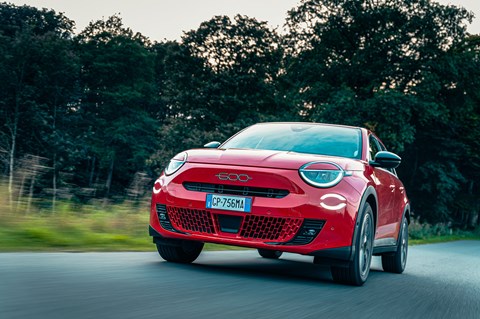
There’s a bit of copycat in the driving experience, too, this time with its Jeep Avenger sibling. When it comes to ride comfort and refinement, that’s a good thing. The 600e waltzes genteelly and quietly over Tversted’s vast speed bumps, thanks to a loping and compliant primary ride. The body sometimes bellyflops in sharp dips and the 18-inch wheels can kerthunk into manhole covers but it’s certainly a comfy way to travel.
Unsurprisingly for an urban SUV the steering is extremely light, but this induces a sense of looseness off the dead-ahead and imprecision in corners. Around town the set-up is like a wobbly string of spaghetti; thankfully it becomes al dente at speed, triggering responses that feel more urgent and direct.
You sit low in a very car-like position, on ivory synthetic leather seats with powered adjustment and inadjustable Fiat logos stitched all over. And I thought head restraints embossed with mainstream brand crests showed delusions of grandeur…
This is a small car, a feeling enhanced by the cramped footwell, where the XXL foot rest compromises a long-legged driver’s ability to stretch out. Rear passengers get a similarly claustrophobic feeling: raising the seats has liberated an extra 30mm of legroom compared with the Jeep, but my knees still rub against the front seat backs. Use the Fiat 600e as a 2+2. A longer rear overhang also makes for a marginally bigger boot, stowing 360 litres of luggage, with an underfloor compartment taking the charging cable.

The Fiat’s clean, simple cockpit seems in a different league to the Hyundai’s techy button-fest and the digitally-dominated Honda. An LED light strip bathes a Spitfire-wing dashboard in a choice of eight shades (‘colour therapy’ in Fiat speak), there’s the obligatory touchscreen and separate switch banks control the air-con and gear selection.
Press D to drive, punch it a second time for Brake mode to amp up the natural-feeling regular deceleration. Lift as you close on a corner and the regenerative brakes more eagerly wipe off speed, preparing the Fiat for the turn. The 600e rolls noticeably as it sweeps through corners: it’s not ungainly but feeling a little less planted is the price you pay for that ride comfort. You sometimes have to push through a little brake pedal mushiness before the car stops confidently in its tracks.
The 0-62mph acceleration sprint takes 9.0sec, more than a second slower than the Honda or Hyundai. It’s not that the Fiat feels sluggish; the 115kW (154bhp) electric motor has sufficient low-down shove to feel sprightly in isolation and has more than enough to joust with city traffic. But the bigger, heavier Asian SUVs just have more punch out of rural Denmark’s high-speed corners and pile on pace when the speed limit relaxes. The Fiat has the quietest e-motor and motorway refinement though, suppressing tyre grumble and wind noise smartly.

Over our test loop mixing urban trundling, fast rural roads and highway speed stretches, the 600e averaged 3.70 miles per kWh consumed. That’s not too far off the 4.09 miles per kWh official WLTP figure, which also calculates the maximum range to be 252 miles. Our testing pegs range at about 190 miles in the real world. A standard heat pump will boost efficiency; the maximum charge rate on DC public chargers is 100kW.
With the cars dormant on a cobbled parking lot beside an immaculate farm, I jump in the Hyundai Kona Electric next. Instantly noticeable is the steering’s greater heft and directness compared with the Fiat’s, commanding the nose to swoop into turns with more immediacy.
There’s a series of fast, open corners scything through the green fields. Into the sweeping 70mph left-hander, the Kona sways outward nonchalantly, the nose clinging on effortlessly. There are similar good vibes through a slower chicane created by traffic calming measures: the responsiveness just off the dead-ahead makes the Kona jink through kinks more deftly.
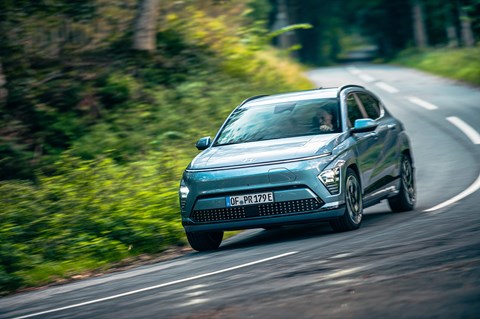
The front-mounted electric motor provides good punch across the rev range: with 160kW (215bhp) it’s got this trio’s highest peak power, although both the Fiat and Honda best it for max torque. The Hyundai’s motor is more audible than the Fiat’s, with a friendly hum under hard acceleration and braking.
The Kona Electric has the best braking system. Pedal feel is crisp, but it’s the four-tier regenerative braking that provides the trio’s most engagement and flexibility. It’s familiar from multiple Hyundai and Kia EVs, and baffling that more car makers haven’t stolen its functionality.
Simply crank the left paddle to increase the regenerative force in steps, with the fourth setting being i-Pedal and prodigious deceleration the instant you step off the accelerator enabling one-pedal driving. Dial back the force with the right paddle. You can choose which tier suits you best and the Kona stays in that setting, but with the click of a paddle you can swiftly add or subtract braking force as you approach a corner. It’s a game the Fiat doesn’t really try to play, and the Honda just messes up.
The Kona’s ride feels more taut than the Fiat’s, and it fidgets and rumbles more over the ravaged tarmac entering the town of Bindslev but glides smoothly over the speed bumps. Accelerating from 40mph to motorway speeds, wind noise around the screen builds and the tyres murmur; the 600e has the edge on refinement.

The Hyundai’s cockpit is a mixed bag. The seats are comfy and supportive, there are charging ports everywhere and a lovely touchscreen widget that displays whatever additional info you need. Some of this Ultimate trim’s features – the crystal-clear Head-Up Display, the 3D bird-view manoeuvring camera – feel more limousine than small SUV.
The less successful stuff? The speaker adjoining the digital driver’s binnacle looks like a poverty-spec blanked off area, the lidded central cubbyhole has an odd open design making it useless for hiding valuables and there are a bewildering number of switches.
Rear space is remarkable for a compact car, with the copious headroom exacerbated by slumping, heated back seats. The boot is the biggest on test, and there’s 27 litres of additional stowage in a frunk.

The Kona posted 3.36 miles per kWh in testing compared with a 4.23-mile official rating. That would make it good for 220 miles rather than the 319 miles claimed for the 65.4kWh battery. Max DC charging is pegged at 102.3kW.
Into the Honda e:Ny1, which feels the most SUV-like with its high seating position and tall dashboard wrapping around you like a boat’s prow. Switches are scarce apart from to select gears, drive modes and parking commands, apart from one other massive control that’s an ornate chromed dial to adjust – of all things – air vent flow. Most functions are grouped on a portrait-oriented, 15.1-inch touchscreen that dominates the dash, thankfully with the important air-con controls always prominent.
This Advance model costs an eye-watering £47,195, with upgrades including a heated steering wheel, automated parking and powered tailgate. It also has twin glass roof panels which combine with the lovely pale synthetic leather for a delightfully airy cockpit. The padded elbow rests feel sumptuous and rear space is as bounteous as the Hyundai’s.

Pull away and you’re assailed by electric motor whine, with the 150kW (201bhp) unit summoning a meaty 229lb ft of grunt. The engineers have limited torque delivery under 10mph for smoother getaways, but the Honda is still the punchiest on test with occasional torque steer and squealing tyres if you’re a bit careless with the ‘loud pedal’. And it really is a loud pedal when that mewling motor takes it up a notch under acceleration.
The e:Ny1 sounds the loudest at motorway speeds, with the greatest wind noise and that always-on chirrup. Honda must have orchestrated that e-motor sound to boost driver engagement, but with more whine than Italy’s Veneto region it’s irritating at a cruise and wearisome around town.
And the firm Honda is the most troubled over Bindslev’s scarred surfaces, with the tyres rumbling away as they transmit a wave of jiggles to the cockpit, and crash through the odd pothole. Speed bumps can induce head toss too.

Out on the rural twisties, the steering feels more stately and less responsive than the Hyundai’s. And while the e:Ny1 can match the Kona for cornering speeds, it displays less composure and agility and threatens to break into understeer more easily. Considering Honda has engineered some fantastic front-wheel drive cars over the years, the e:Ny1 lacks its customary élan.
The brake pedal is responsive and effective but there’s a rather odd take on paddle-operated regen. In theory, the Honda’s right paddle provides a mild boost of retardation, which you can intensify with up to two additional pulls on the left paddle. But the calibration between levels isn’t very distinct and irritatingly the system quickly resets, preventing you maintaining your preferred option. It feels like Honda wants to keep humans at the heart of the driving experience but has flunked it with an overly nuanced and complex approach.
In our testing the Honda managed 3.3 miles per kWh, which would give it a 204-mile range. Officially the e:Ny1 covers 3.41 miles per kWh and 256 miles in total. Maximum DC charging is 78kW: that may sound outgunned by its peers, but Honda says the lower figure enables a more consistent charging peak, to replenish the battery from 10 to 80 percent in 45 minutes.
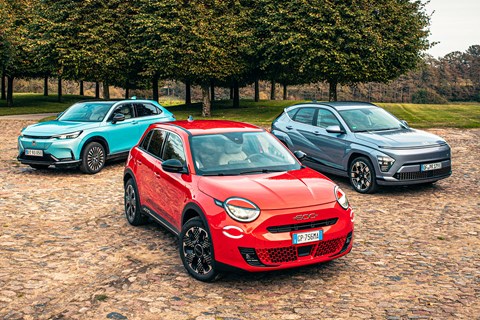
Verdict: Hyundai Kona Electric vs Fiat 600e vs Honda e:Ny1
The compact electric crossover market is really hotting up. Car fans may fret that driving will become less characterful in the electric age, and the e:Ny1 could be used to bolster that argument. It’s a conservative reaction to Honda’s unusual but unsuccessful E city car, next launching a trad electric crossover with a competitive range. Nothing wrong with that, it’s what the market wants.
Maybe I’m being too anthropomorphic here, but the e:Ny1 has tried to retain some Honda DNA: a vocal powertrain, its own take on regenerative braking and a sporty-feeling suspension set-up. Unfortunately all three turn out to be weaknesses: the Honda is the least quiet and comfortable of the trio.
On straight-line performance, the e:Ny1 narrowly beats the Hyundai, but its steering and dynamics aren’t as involving. Which leaves Honda’s trump card to be the nicest cabin with lots of space and the plushest materials, but rightly so given it’s just £6k less than a basic Porsche Macan. The Honda takes the bronze medal in our Hyundai Kona Electric vs Fiat 600e vs Honda e:Ny1 test.
The Fiat 600e offers something different to its Asian sparring partners, a genuinely smaller urban e-SUV at a lower price. But due to its shared hardware the refined, comfortable driving experience is just too similar to the aforementioned Avenger. The originality of the Fiat 500e – the Dolce Vita soundtrack on start-up, embossed classic 500 and Turin skylines in the cabin, replacing door handles with push buttons – no such characterful quirks enliven the 600e.
That said it’s simple to use and proved the most efficient on our loop, assisted by its lighter weight and smaller frontal area. This package will be just right for some punters but they’ll have to choose between the cutesy Fiat and the tougher Jeep.
The new Kona Electric is instantly identifiable despite its useful growth spurt. It sharpens the Mk1’s bulging wheelarches with light clusters sliding off like eggs out of the frying pan and retains the untidy charge socket sticking out like a sore nose.
But it’s a deeply competent car to drive and edges out its rivals with a host of marginal gains: more incisive steering, the best brakes, the e-motor which best balances performance and civility, the most confident in corners. And it’s packed with sophisticated features and lots of space for people and things, at a keen price.
If you’re looking for a nicely sorted front-wheel drive e-crossover, ink the Hyundai Kona Electric onto your consideration list.
Fiat 600e La Prima

THE LINE-UP
The 600e gets two trim levels at launch, the entry-level Red for £32,995 (also available in white) and the La Prima edition for an extra £4k. Both cars have a 51kWh usable battery and 115kW front motor. Red gets 16-inch wheels, keyless go, twin digital screens with wireless smartphone connection. La Prima adds goodies including 18-inch alloys, powered/heated front seats, navigation, upgraded audio, a rear parking camera and automated stop/go cruise control.
SPECS
Price: £36,995
Powertrain: 51kWh battery, single electric motor, front-wheel drive
Performance: 115kW (154bhp), 192lb ft of torque, 9.0sec 0-62mph, 93mph top speed
Weight: 1520kg
Efficiency: 4.09 miles per kWh (claimed), 3.70 miles per kWh (tested), 252-mile range (claimed), 189-mile range (tested)
Length/width/height: 4171/1781/1523mm
Boot capacity: 360 litres
Honda e:Ny1 Advance
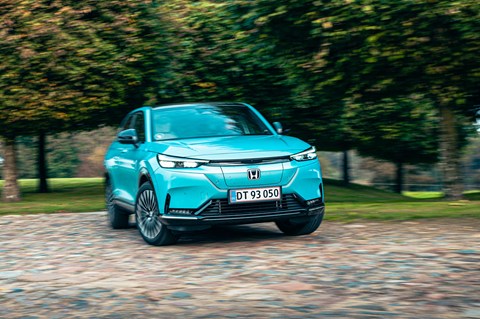
THE LINE-UP
Like the Fiat, the Honda e:Ny1 comes with a standard battery and motor and two trim levels. The £44,995 Elegance model has the 15.1-inch touchscreen, keyless entry, heated/powered front seats and rear-view camera. Upgrade to £47,195 Advance for a heated leather steering wheel, powered tailgate, glass roof and Honda’s parking pilot.
SPECS
Price: £47,195
Powertrain: 61.9kWh battery, single electric motor, front-wheel drive
Performance: 150kW (201bhp), 192lb ft of torque, 7.7sec 0-62mph, 99mph top speed
Weight: 1752kg
Efficiency: 3.41miles per kWh (claimed), 3.30 miles per kWh (tested), 256-mile range (claimed), 204-mile range (tested)
Length/width/height: 4387/1790/1584mm
Boot capacity: 344 litres
Hyundai Kona Electric Ultimate
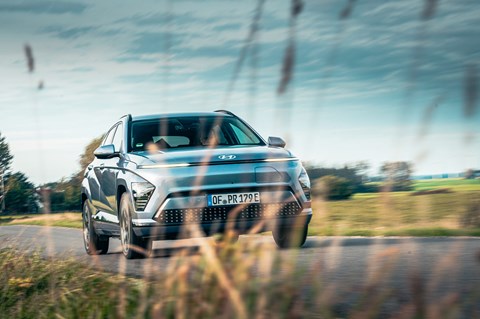
THE LINE-UP
Hyundai offers by far the broadest line-up, with two battery options and four trims. Entry-level Advance – with cloth seats, 17-inch rims, nav, rear parking camera and smartphone integration – can be had with the 48.4kWh battery for £34,995 or £38,595 for the 65kWh pack. N Line and N Line S add more kit until you reach the tech-laden £43,095 Ultimate trim we tested.
SPECS
Price: £43,095
Powertrain: 65.4kWh battery, single electric motor, front-wheel drive
Performance: 160kW (215bhp), 188lb ft of torque, 7.8sec 0-62mph, 107mph top speed
Weight: 1795kg
Efficiency: 4.23 miles per kWh (claimed), 3.36 miles per kWh (tested), 319-mile range (claimed), 220-mile range (tested)
Length/width/height: 4355/1825/1575mm
Boot capacity: 466 litres + 27-litre frunk
More comparison tests by CAR magazine